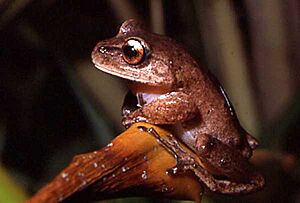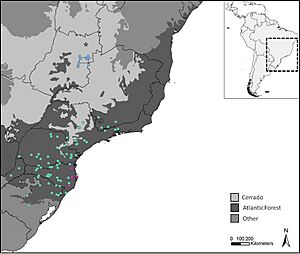Aplastodiscus cochranae facts for kids
Quick facts for kids Aplastodiscus cochranae |
|
|---|---|
 |
|
| Conservation status | |
| Scientific classification | |
 |
|
| The species is found in pink triangles. | |
| Synonyms | |
|
Hyla cochranae Mertens, 1952 |
The canebrake treefrog, officially known as Aplastodiscus cochranae, is a type of frog. It belongs to the Hylidae family, which includes many treefrogs. This special frog lives only in the coastal mountains of Santa Catarina, Brazil. It's named after Doris Mable Cochran, a famous American scientist who studied reptiles and amphibians.
Contents
What Does This Frog Look Like?
These frogs are quite sturdy. Adult males are about 41 to 46 millimeters (1.6 to 1.8 inches) long. Females are a bit bigger, measuring 45 to 50 millimeters (1.8 to 2 inches) from their snout to their rear end.
- Head and Face: Their snout is usually rounded. They have a visible eardrum, called a tympanum, which is covered by skin. A black line runs from their nostril to their eye.
- Hands and Feet: Their fingers have large, sticky pads, which help them climb. There is also some webbing between their fingers. Their toes also have sticky pads, but they are smaller than the ones on their fingers. They have webbing between their toes too.
- Color: Their back can be cream-colored, rosy, or reddish-brown. It often has tiny dark spots called melanophores. Their belly is light pink, and their sides and joints can have violet colors.
- Sounds: Male frogs have a single vocal sac under their throat. They inflate this sac to make calls, especially when looking for a mate.
Baby Frogs (Tadpoles)
Young Aplastodiscus cochranae are called tadpoles. When they are almost ready to become frogs, they are grayish-brown on top and grayish underneath. They can be about 62 to 64 millimeters (2.4 to 2.5 inches) long. About one-third of this length is their body, and the rest is their tail.
Where Do These Frogs Live?
Aplastodiscus cochranae frogs live in the lower parts of rainforests. You can find them at the edges of these forests, usually at heights of 500 to 800 meters (about 1,640 to 2,625 feet) above sea level.
How They Reproduce
These frogs lay their eggs in small holes in the ground that are filled with water. This is where their tadpoles will grow and develop.
How Are These Frogs Doing?
Good news! The Aplastodiscus cochranae is a common frog, and its numbers seem to be steady. This means there are plenty of them around.
However, there is one main threat to these frogs:
- Cattle: Farm animals like cattle can cause problems. They might trample on the plants where the frogs live. They can also pollute the water where the frogs breed.
To protect these frogs, they live in special areas like the Serra do Tabuleiro State Park. They are also found in several private nature reserves. These protected places help keep their habitat safe.


